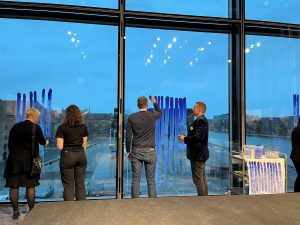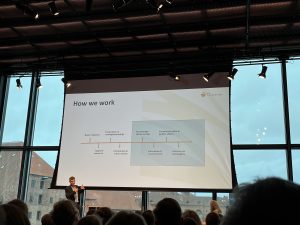In their annual conference in Copenhagen in November, the Nordic foundations grappled with the notion of ESG and what it means for their donations, their investments and their footprints. The grouping of the three may prove to a thorny problem for foundations. Specifically, there was more to say about the E (environmental) and the S (social) than the G (governance) which, despite efforts in the conference workshops to prove the contrary, emerged as the inconvenient extra.

‘Our lives begin with an inhale and end with an exhale’, said Breathe With Me artist Jeppe Hein.
Not surprisingly, it was the E that really dominated the early proceedings, to the point where delegates might have assumed they were attending a conference on climate change. A number of speakers emphasised the fact that it is the gravest crisis we have faced and participants were reminded that, concurrently, the COP meeting was taking place in Egypt (the conference title is a reference to the film ‘Don’t Look Up!’ which satirises political and public indifference to the climate crisis. The conference title, by contrast, urged participants not to bury their heads in the sand). Kirsten Brosbøl former Danish Minister for the Environment and now CEO of 2030beyond issued a grim climate forecast and warned the conference that, in terms of global warming, we ‘are on the highway to hell, with our foot on the accelerator’. She then attempted to resolve a point of confusion.
The abbreviations SDG and ESG are not a million miles apart and though distinct, are easy to mix up. She provided an ingenious solution to describe the relationship between them: for foundations, the SDGs are the ‘outside-in’, ESG is the ‘inside-out’. In other words, the Goals provide a framework for foundations to assess their ESG responsibilities and a means of measuring them. Their response should be to get their houses in order (do no harm), look at their investments and make sure their philanthropy is as effective as possible. For her, that means above all collaboration. The key to achieving the other 16 SDGs, she said, is #17, partnership. She urged them to build bridges to other sectors and not to be afraid of politics. The Nordic countries have an advantage, she believes, in that their societies are founded on transparency and accountability and have strong institutions (what she termed their ‘superpower’). They enjoy a high degree of trust. And, she insisted, the elements of ESG are inseparable: ‘if you don’t have functioning democracies, you will be unable to implement long-lasting change.’
Don’t look inwards, look outwards
The cases then presented by individual foundations dwelt, though, on their efforts in regard to the environment and to society. Anni Syrjäläinen of the Nordic Culture Foundation explained how culture shapes our responses to the world and can contribute to our welfare and survival in the face of crises. She highlighted one of NCF’s initiatives in which strengthening the role of music in isolated communities in the Faroes, Greenland and Alaska has helped them become more resilient in times of difficulty, not only asserting tradition, but showing ways in which what she called the music ecosystem could produce social and even economic side-benefits in terms of cohesion and job creation. She urged the conference not to look inwards. It’s tempting in times of crisis, but it’s a mistake. The key for her is increasing global focus in foundations’ work.
It’s not whether we’re going to do it, it’s how we’re going to do it.
 ‘Everyone of us is required to take action,’ asserted Ulla Tuomarla of the Kone Foundation in Finland for which has evolved a new value based on responsibility for humans, for other species and for the environment. Kone supports the Saari Residence which has become a test bed for a different way of life. The residents who are international artists, explore more sustainable ways of living through, for example, vegan food, recycling, slow travel, birdwatching and mushroom picking.
‘Everyone of us is required to take action,’ asserted Ulla Tuomarla of the Kone Foundation in Finland for which has evolved a new value based on responsibility for humans, for other species and for the environment. Kone supports the Saari Residence which has become a test bed for a different way of life. The residents who are international artists, explore more sustainable ways of living through, for example, vegan food, recycling, slow travel, birdwatching and mushroom picking.
The climate crisis was back to centre-stage with the work of the KR Foundation, part of the V Kann Rasmussen family of foundations which includes the Velux Foundation, and which Brian Valbjørn Sørensen described as a ‘large environmental project which funds environmental projects’ across the whole spectrum of research, communications and company value chains. Foundations, he said, have come late to the climate issue, but they could all incorporate it to some extent by looking at by taking active ownership of their investments, their own operations and influencing their grantees.
This brought us back to ESG. How could foundations apply ESG to their grants process and what would it mean to do so, wondered Birgitta Forsström of Finland’s Stiftelsen Brita Maria Renlunds?
Can foundations do more towards creating a carbon-neutral city in an intelligent and cost-effective way? Yes!
The question was one of those debated in workshops under the title ‘Look at Yourself’, on each of the three elements. Esben Lanthén of the consultancy Nordic Sustainability and Henrik Mahncke of Realdania who led the governance workshop both insisted that, far from being the forgotten letter of the three, G was actually the most important especially at a time when foundations were under pressure externally and often scrutinising themselves internally to demonstrate their impact and how they achieved it. It was crucial, said Lanthén, echoing what Kirsten Brosbøl had said earlier, for foundations to get their own houses in order. Again, though, while seeing its importance, delegates struggled with how to apply the ESG notion to their activities. There are clear risks both internally and externally – risks to reputation, risk of conflict of interest among board members, lack of diversity among board membership, risks from grantee behaviour – but how to offset these risks was less clear. As one participant put it: ‘it’s not whether we’re going to do it, it’s how we’re going to do it.’ Nor, tellingly, was much said about the opportunities which might be afforded by embracing an ESG framework.
What emerged from the workshops was that E, S and G don’t always sit together well. Summing up the results of the three, Esben Lanthén noted that ESG competencies among Nordic foundations are limited, that impact measurement and reporting to grantees are key, that increased focus on ESG may make foundations more, rather than less, risk-averse and that ESG approaches need to be integrated across the sector. This was in response to a number of participants noting that the behaviour of one could tarnish the reputation of all: in other words, sink or swim together.
‘Wicked problems need partnerships’
However, if the chosen conference theme was ESG, a key part of this approach meant an emphasis on more familiar concepts like partnership, collaboration and measurement. Ingrid Riddervold Lorange of the Gjensidige Foundation in Norway stressed the first two and explained how their approach to grantmaking had changed over time from being applicant-driven to becoming more strategic and development-oriented. For grantee relations, this means moving from little involvement to much closer relationships. It also means moving towards greater collaboration with other stakeholders because ‘wicked problems need partnerships.’ She gave as an example the Nordic Safe Cities (NSC) initiative in which Gjensidige is both funder and member. From the other side, Lotte Fast Carlsen of NSC also stressed the importance of long-term partnership with the foundation, remarking ‘we need time to work.’ For this reason, Gjensidige has made stipulations on grants it makes through the programme: that the cities applying enter into partnership with at least one CSO, that grantees share knowledge with other cities and that they must be willing to contribute to joint network initiatives.
Project Zero
If the general climate prognosis is gloomy, at least one presentation at a conference will offer a ray of hope. Project Zero is one of these. ‘Can foundations do more towards creating a carbon-neutral city in an intelligent and cost-effective way?’ wondered Head of the Project, Lars Tveen rhetorically. His answer was a resounding ‘Yes!’ Again, he stressed cooperation and, echoing Kirsten Brosbøl, he spoke of the ‘trust culture’ of Nordic countries and how this is a prerequisite for such cooperation.
Twenty years ago, in an effort to revive the declining Danish city of Sønderborg, Danfoss, an energy and climate solution company and its foundation, the Clausen Foundation, which are headquartered in the city, commissioned the Monitor Institute to find a way to regenerate the community. Part of the plan which emerged is Project Zero, an initiative of the Clausen Foundation, under which the city will decarbonise its energy production by 2029. That this is real intent, not wishful thinking is shown by current figures. It has already been halved since the project began in 2017. Tveen offered a straightforward prescription: secure local engagement, create an intelligent and cost-effective plan, organise local action, drive performance management and, above all, don’t wait – the solutions are there. In more concrete terms, he offered three keys, energy efficiency, energy re-use and renewable energy. He stressed the importance of the scale of the project. It’s a global problem, but it needs a global solution.
Crucial to the success of the initiative was that the Clausen Foundation had backed it to get it going in the first place. ‘As a foundation, we can do that,’ said Per Egebaek Have, CEO of the Foundation. In short, it had used that much-touted advantage of foundations – the ability to take risks. But Danfoss is a big presence in Sonderbørg, objected one participant. What if there isn’t a local equivalent? Danfoss and the foundation were necessary for the first step, to overcome the inertia, said the presenters. Now it is moving, it has its own momentum. Lars Tveen acknowledged that citizen involvement had been and still was a challenge which needs a lot of effort in terms of communication, but the pay-off in terms of, for example, lower energy bills was persuasive.
ESG – translation needed
So what did participants learn? Most seemed happier looking outwards at how the letters E and S applied to their missions, than inwards at what they meant for their operations. The G remained a stubborn outlier. In a final panel, the consensus was that, while some progress had been made towards understanding the application of ESG to the work of foundations, much more work was needed. Clearly, foundations take very seriously the preservation of the environment and the welfare of society in their work and/or their explicit aims. There was obviously some difficulty in seeing where and how the governance concept fitted in helping them to achieve those aims. ‘We need a translation, as Hanne Rasmussen of the Danish Knowledge Centre remarked. Symptomatic of the problem of applying the concept is the fact that it had been difficult to find presenters for the conference. ‘Until it is translated into what you are doing, it’s hard to think about it,’ said Rasmussen.
Looking for new means
The conference really resolved itself into two parts: discussion of work and progress towards environmental and social goals and the application of ESG. The two proved difficult to weld together, even if they are straining towards the same goal. Perhaps it was Birgitta Forsström of Finland’s Stiftelsen Brita Maria Renlunds really encapsulated the underlying preoccupation of the conference. Her foundation deals with the welfare of children. The problems they now face – mental well-being, inequality – aren’t the ones they used to face. This year, they have developed a new strategy. They weren’t alone. Others spoke of rethinking a previous approach and adopting a new one, In a sense, all of those present are looking for a way to reconfigure themselves and their work to adapt to changing times and problems.
First and last
The connection between art and the SDGs may not seem obvious, but…’our lives begin with an inhale and end with an exhale,’ said artist Jeppe Hein. He has devised the ‘Breathe With Me’ project which highlights the collective. As they exhale, participants paint vertical blue stripes on a blank wall or canvas for as long as one breath lasts. Others follow and paint a similar stripe next to the last one, so the stripes forms a continuous mural. The project has so far been held in over 15 countries and, according to its organisers, helps individuals visualise their participation in and responsibility for the world around them. Quotes from participants illustrate its striking effect: ‘breath is an exchange with the environment’, ‘we all breathe the same air’. Art changes people, concludes Jeppe Hein, and people change the world.
So was the potential ignited? There were many sparks and some evidence of smouldering, but the overall feeling is that it has yet to catch fire.
Andrew Milner is Features Editor at Alliance.



Comments (1)
Birgitta Forsström, Stiftelsen Brita Maria Renlunds minne sr comes from Finland (not Norway)